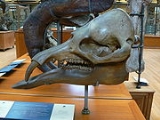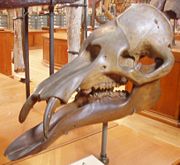
Phiomia
Encyclopedia
Phiomia is an extinct genus of basal proboscid that lived in what is now Northern Africa
during the Late Eocene
to Early Oligocene
some 36-35 million years ago. "Phiomia serridens" means "saw-toothed animal
of Faiyum".

 Phiomia was around 2.5 metres (8.2 ft) high, and vaguely resembled a modern elephant
Phiomia was around 2.5 metres (8.2 ft) high, and vaguely resembled a modern elephant
, although, based on the shape of its nasal bone
s, it had only a very short trunk. It had short tusks on the upper jaw and also short shovel-like tusks on the lower jaw that were most likely used for gathering food. These were similar to those of the Miocene
Platybelodon
, Archaeobelodon
, and Amebelodon
, but considerably smaller. The tusks in the upper jaw may have been used in defence, or scraping bark off trees.
Africa
Africa is the world's second largest and second most populous continent, after Asia. At about 30.2 million km² including adjacent islands, it covers 6% of the Earth's total surface area and 20.4% of the total land area...
during the Late Eocene
Eocene
The Eocene Epoch, lasting from about 56 to 34 million years ago , is a major division of the geologic timescale and the second epoch of the Paleogene Period in the Cenozoic Era. The Eocene spans the time from the end of the Palaeocene Epoch to the beginning of the Oligocene Epoch. The start of the...
to Early Oligocene
Oligocene
The Oligocene is a geologic epoch of the Paleogene Period and extends from about 34 million to 23 million years before the present . As with other older geologic periods, the rock beds that define the period are well identified but the exact dates of the start and end of the period are slightly...
some 36-35 million years ago. "Phiomia serridens" means "saw-toothed animal
Animal
Animals are a major group of multicellular, eukaryotic organisms of the kingdom Animalia or Metazoa. Their body plan eventually becomes fixed as they develop, although some undergo a process of metamorphosis later on in their life. Most animals are motile, meaning they can move spontaneously and...
of Faiyum".


Elephant
Elephants are large land mammals in two extant genera of the family Elephantidae: Elephas and Loxodonta, with the third genus Mammuthus extinct...
, although, based on the shape of its nasal bone
Nasal bone
The nasal bones are two small oblong bones, varying in size and form in different individuals; they are placed side by side at the middle and upper part of the face, and form, by their junction, "the bridge" of the nose.Each has two surfaces and four borders....
s, it had only a very short trunk. It had short tusks on the upper jaw and also short shovel-like tusks on the lower jaw that were most likely used for gathering food. These were similar to those of the Miocene
Miocene
The Miocene is a geological epoch of the Neogene Period and extends from about . The Miocene was named by Sir Charles Lyell. Its name comes from the Greek words and and means "less recent" because it has 18% fewer modern sea invertebrates than the Pliocene. The Miocene follows the Oligocene...
Platybelodon
Platybelodon
Platybelodon was a genus of large herbivorous mammal related to the elephant . It lived during the Miocene Epoch, about 15-4 million years ago, and ranged over Africa, Europe, Asia and North America...
, Archaeobelodon
Archaeobelodon
Archaeobelodon is an extinct genus of proboscidea of the family Gomphotheriidae endemic to Europe and Africa during the Miocene from 16.9—16.0 Ma, living for approximately ....
, and Amebelodon
Amebelodon
Amebelodon is a member of a diverse group of primitive proboscideans called gomphotheres, a group that also gave rise to the modern elephants and their close relative the mammoth. The most striking attribute of this animal is its lower tusks, which are narrow, elongated,and distinctly flattened...
, but considerably smaller. The tusks in the upper jaw may have been used in defence, or scraping bark off trees.

